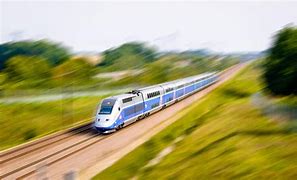President Bola Tinubu inaugurated the Red Line Rail Project in Lagos on February 29 2024, . The project, an intra-state rail service aimed at improving transportation within the city, spans 37 kilometres.
The Red Line Rail Project in Lagos, Nigeria, represents a significant infrastructure development aimed at improving transportation within the city.
Here are 5 things to know about the new Lagos’ Red Line Rail project
1. Linking the city
The Red Line isn’t just another train track; it’s envisioned as a crucial link in Lagos’ larger rail network, connecting the city to the Lagos-Ibadan corridor. Spanning 37 kilometers, it shares its right-of-way with the existing Lagos-Kano Standard Gauge Railway. But for now, the initial operational route stretches from Agbado in Ogun State to Oyingbo in Lagos, making key stops in major areas like Ikeja, Oshodi, and Yaba.
2. The project cost
The Red Line project is a substantial investment in Lagos’ urban transportation infrastructure. Initial estimates pegged the cost at $135 million under the Greater Lagos Urban Transportation Project, managed by the Lagos Metropolitan Area Transport Authority (LAMATA).
However, Governor Babajide Sanwo-Olu revealed that both the Blue and Red Lines combined would exceed ₦100 billion. Delays in the Blue Line project, initially expected to be completed by 2011, highlight the funding challenges faced by the project.
3. Attending to about 500,000 passengers each day
The Red Line is spearheaded by LAMATA, the Lagos Metropolitan Area Transport Authority, operating under the Ministry of Transportation. Once fully operational, it’s expected to offer 37 daily trips, catering to an estimated 500,000 passengers. The key goals are to reduce commute times, improve air quality by reducing traffic congestion, and ultimately, boost economic productivity.
4. Diesel powering the Red engine
Unlike the electric-powered Blue Line, the Red Line utilizes a Diesel Multiple Unit (DMU) system. This means individual train cars are equipped with their own diesel engines, offering flexibility and efficient operation based on the project’s specific needs.
5. Investment in safety
Beyond the train tracks themselves, the Red Line project has invested heavily in safety and passenger experience. This includes constructing 10 vehicular overpasses and pedestrian bridges, ensuring the safe separation of train traffic from car and pedestrian movement.
Aspects clés du projet ferroviaire Lagos Red Line que vous ne saviez probablement pas
Le président Bola Tinubu a inauguré le projet ferroviaire Red Line à Lagos le 29 février 2024 ,. Le projet, un service ferroviaire intra-étatique visant à améliorer le transport dans la ville, s’étend sur 37 kilomètres.
Le projet ferroviaire Red Line à Lagos, au Nigéria, représente un développement important des infrastructures visant à améliorer les transports au sein de la ville.
Voici 5 choses à savoir sur le nouveau projet de rail rouge de Lagos
1. Lier la ville
La ligne rouge n’est pas seulement une autre voie ferrée; Il est envisagé comme un lien crucial dans le plus grand réseau ferroviaire de Lagos, reliant la ville au couloir Lagos-Ibadan. S’étendant à 37 kilomètres, il partage son emprise avec le chemin de fer de la jauge standard de Lagos-Kano existant. Mais pour l’instant, l’itinéraire opérationnel initial s’étend d’Agbado dans l’État d’Ogun à Oyingbo à Lagos, faisant des arrêts clés dans les principales zones comme Ikeja, Oshodi et Yaba.
2. Le projet coûte
Le projet Red Line est un investissement substantiel dans les infrastructures de transport urbain de Lagos. Les estimations initiales ont fixé le coût à 135 millions de dollars dans le cadre du Greater Lagos Urban Transportation Project, géré par la Lagos Metropolitan Area Transport Authority (LAMATA).
Cependant, le gouverneur Babajide Sanwo-Olu a révélé que les lignes bleues et rouges combinées dépasseraient 100 milliards de livres. Les retards dans le projet Blue Line, qui devraient initialement être achevés d’ici 2011, mettent en évidence les défis de financement auxquels le projet est confronté.
3. Assister à environ 500 000 passagers par jour
La ligne rouge est menée par Lamata, la Lagos Metropolitan Area Transport Authority, opérant sous le ministère des Transports. Une fois pleinement opérationnel, il devrait offrir 37 voyages quotidiens, avec environ 500 000 passagers. Les objectifs clés sont de réduire les temps de trajet, d’améliorer la qualité de l’air en réduisant la congestion du trafic et, finalement, à stimuler la productivité économique.
4. Diesel alimentant le moteur rouge
Contrairement à la ligne bleue à propulsion électrique, la ligne rouge utilise un système diesel multiple (DMU). Cela signifie que les voitures de train individuelles sont équipées de leurs propres moteurs diesel, offrant une flexibilité et un fonctionnement efficace en fonction des besoins spécifiques du projet.
5. Investissement dans la sécurité
Au-delà des voies ferrées elles-mêmes, le projet Red Line a investi massivement dans la sécurité et l’expérience des passagers. Cela comprend la construction de 10 virsses de véhicules et des ponts piétonnes, assurant la séparation sûre de la circulation des trains de la voiture et du mouvement des piétons.



